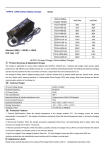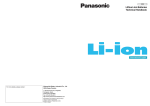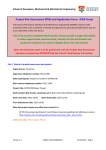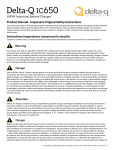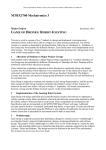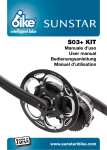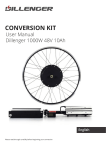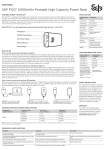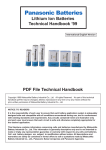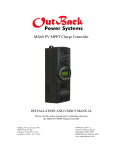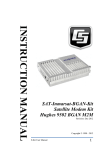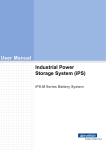Download user manual - Balqon Corporation
Transcript
BALQON CORPORATION HIQAP ENERGY STORAGE SYSTEM USER GUIDE 12 Volt Systems HIQAP ENERGY STORAGE SYSTEM USER GUIDE Notice of Copyright HIQAP Energy Storage System USER GUIDE Copyright © 2012 all rights reserved. No part of this document may be reproduced in any form or disclosed to third parties without the express written consent of Balqon Corporation, 1420, 240th Street, Harbor City, CA 90710. Balqon Corporation reserves the right to revise this document and make periodic changes to the contents without obligation or organization of such changes and revisions. Disclaimer UNLESS SPECIFICALLY AGREED TO IN WRITING, BALQON CORPORATION (“BALQON”) MAKES NO WARRANTY AS TO THE ACCURACY, SUFFICIENCY OR SUITABILITY OF ANY TECHNICAL OR OTHER INFORMATION PROVIDED IN THIS GUIDE OR OTHER DOCUMENTATION; ASSUMES NO RESPONSIBILITY OR LIABILITY FOR LOSSES, DAMAGES, COSTS OR EXPENSES, WHETHER DIRECT OR INDIRECT, CONSEQUENTIAL OR INCIDENTAL, WHICH MIGHT ARISE OUT OF USE OF SUCH INFORMATION. THE USE OF ANY SUCH INFORMATION WILL BE ENTIRELY AT THE USERS RISKS. Documentation Information Description - HIQAP ESS -12 V Owners Guide Date and Revision - February 2015, Rev A Balqon corporation reserves the right to update the contents of this manual from time to time without any notification. Please access the most current version of this manual under Support section on our website www.BALQON.COM Contact Information BALQON CORPORATION 1420, 240TH STREET HARBOR CITY, CA 90710 USA Telephone: Fax: Web: 310-326-3052 310-326-3058 www.balqon.com About the Guide The purpose of this user guide is to provide important information and instructions for installing and wiring the HIQAP® energy storage system. This guide does not provide details about certain components that can be attached to the HIQAP ESS. You need to refer to the individual components owners guide’s for this information. This user guide is intended for qualified installers, electrical contractors licensed to install electrical equipment. The installer should have the knowledge and experience in installing electrical equipment, battery systems, knowledge of the applicable installation codes, and awareness of the hazards involved in performing electrical work and how to reduce such hazards. Safety Precautions • • • • • • • • • • • • All electrical work shall me performed in accordance with local and national electrical codes. This product is designed for indoor installation, it must not be exposed to direct sunlight, rain, snow or any liquids of any type. Voltage is present at the battery terminals, use insulated tools and gloves while working on the product. Always turn off equipment connected to the product in addition to turning OFF the switch provided on the HIQAP system to isolate the batteries from other electrical circuits, before performing any repairs or maintenance on the system. Always use proper wire sizes to connect the HIQAP ESS system to inverters, charge controllers or other equipment. Always use crimped connections to connect to the battery terminals. Always mount HIQAP ESS system in an upright position. Read and follow the inverter, charge controller manufacturers safety precautions prior to connecting the HIQAP ESS system to other equipment. Remove all jewelry such as rings, watches, bracelets and other metal objects when installing or maintaining the system. Lithium battery can produce a short-circuit current high enough to cause bodily harm. Never work alone. Always have someone within range of your voice or close enough to come to your aid when working around batteries. HIQAP ESS system can exceed over 100 lbs in weight based on configuration. Use proper lifting techniques and devices while transporting the system. HIQAP ESS system should be installed in a clean dry area that is not exposed to rain, direct sunlight or extreme temperatures (engine compartment, furnace etc.) 1.0 Introduction The HIQAP energy storage systems are designed with lithium Iron Phosphate batteries as a storage device to store energy from various DC input sources like solar, wind, hydro, generator or grid. This storage system can be used in both mobile or stationary applications such as recreational vehicles (RV’s), marine and residential storage. HIQAP-12V is equipped with proprietary battery management system, DC circuit breaker and a fuse to protect the lithium battery cells from over charge or over discharge during daily operations. This system is designed to to be used as a 12 volt system and is configured with different lithium battery cells to store energy up to 18 kWhrs. CHARGE CONTROLLER/INVERTER SETTINGS Battery storage (Watt hours) HQ-12-2K HQ-12-5K HQ-12-9K HQ12-18K 2080 5200 9100 18200 DC Nominal Bus voltage (volts) 13 13 13 13 Maximum charge voltage (volts) 14.2 14.2 14.2 14.2 Discharge rate continuous (watts) 1000 2500 4500 9000 Discharge rate continuous (amps) 80 200 350 700 Inverter discharge voltage termination (volts) 11.8 11.8 11.8 11.8 Maximum charge rate (watts) 1000 2500 4500 9000 Maximum charge voltage (volts) Bulk 13.8 13.8 13.8 13.8 Maximum charge voltage (volts) Absorb 14.2 14.2 14.2 14.2 Maximum charge voltage (volts) Float 13.5 13.5 13.5 13.5 Lithium Batteries Balqon HIQAP energy storage system uses Lithium Iron Phosphate batteries with rare earth yttrium compound that provides long life cycle in a high temperature applications. Lithium Iron phosphate (LiFePO4) batteries are known for its excellent safety and long life when compared to other lithium based batteries. Lithium Iron Phosphate batteries also known as LFP battery are safer than other lithium based batteries due to a stronger molecular bond between Phosphorus and four oxygen atoms. Specifications Chemistry Lithium Phosphate Lithium Cobalt Lithium Manganese Lithium Nickel Lithium Titanate LiFePO4 LiCoO2 LiMn2O4 LiNiMnCoO2 Li4Ti5O12 Nominal Voltage (volts) 3.25 3.60 3.70 3.70 2.40 Specific Energy ( watt-hours/kg) 120 150 100 150 70 Charge rate (C-rate) 1.0 0.7 0.7 0.7 1.0 Discharge rate (C-rate) Cycle life Thermal runaway (temperature °F) 1.0 1.0 1.0 1.0 10.0 3500 500-1000 300-700 1000-2000 4000 518 302 482 410 n/a Table above shows comparisons of various chemistries of lithium batteries. HIQAP energy storage system uses fan folded Lithium Iron Phosphate prismatic cells which are selected for their high cycle life and safety. As shown in the table, LFP batteries have the highest temperature rating for thermal runaway. Lithium Cobalt has the lowest rating which is what lead to recall of batteries in Sony computers in the year 2011. 1.0 Introduction | Lithium Batteries Main Battery negative (-) terminal Accessory Control Contactor Alternator, DC Generator In-line Fuse Main Battery positive (+) terminal Battery Control Module Fault / Warning light; ONOFF Switch; Reset buttton The HIQAP energy storage systems are designed to be connected directly to a Charge controllers and inverter/chargers. ESS systems are shipped with a complete Battery Management System (BMS) and DC contactor controls to protect the battery from over charge, over discharge and over current conditions during daily operations. System Operation Balqon 12 Volt ESS system consists of four lithium battery cells connected in series with each cell nominal voltage of 3.25 volts (pack nominal voltage 13 volts). Each cell is monitored by an individual cell monitor that reports voltage and temperature of each cell to a Battery Control Module Unit (BCM). The BCM contains algorithms and logic software that analyzes the cell data received from monitors. If the cell voltage or temperature data is above or below the specifications the BCM then sends signal to the main DC contactor to open the circuit, thereby isolating the battery pack from other electrical circuits. 1.0 Introduction | System Operation HIQAP - 12V system contains four (4) individual lithium cells connected in series with a nominal voltage of 3.25 volts/cell. HIQAP battery management system is designed to protect individual cells from being charged above 3.8 volts or discharged below 2.6 volts per cell. ESS BMS Status Curve (under normal temperature) 3.8 VDC High voltage shut down 3.8 V 3.6 V 3.6 VDC High Cell Warning Cell Voltage 3.25 V 2.9 VDC Low Cell Warning 2.6 VDC Under voltage shut down 0.5 C 10% 20% 30% 40% 50% 60% 70% 80% 90% 100% Depth of Discharge (DOD) Lithium battery cells used in HIQAP ESS systems have a projected life cycle well in excess of 3,000 cycles at 70% depth of discharge which is estimated to be about four times the life of a conventional deep cycle lead acid battery. The key to achieving this performance is to ensure that each individual cell is protected from being over-charged or over-discharged during daily operation. Listed below are key functions built into the ESS system to ensure battery protection: • Under-voltage Warning: When an individual cell reaches an average voltage of 2.9 volts for a period of 10 seconds an Alert is sent which illuminates the warning light on the Battery Control Module (BCM). Under-voltage warning alarm waits for additional 60 seconds before triggering a Under-voltage protection fault. If the cell voltage is increased during this period the warning resets and system will operate normally. • Under-voltage Cutoff: When an individual cell reaches an average voltage of 2.6 volts for a period of 10 seconds, signal is sent to the main DC contactor to open the contactor and isolate the battery bank from all other electrical circuits. 1.0 Introduction | Lithium Batteries • Over-voltage Warning: When an individual cell reaches an average voltage of 3.6 volts for a period of 10 seconds an Alert is sent which illuminates the warning light on the Battery Control Module (BCM). Over-voltage warning alarm waits for additional 60 seconds before triggering an Over-voltage protection fault. If the cell voltage is reduced during this period the warning resets and system will operate normally. • Over-voltage Cutoff: When an individual cell reaches an average voltage of 3.8 volts as for a period of 10 seconds, signal is sent to the main DC contactor to open the contactor and isolate the battery bank from all other electrical circuits. Battery Control Module Battery Control Module (BCM) is installed in front panel of the HIQAP - 12V ESS system. This module communicates with the cell monitor boards, contactors and relays and also contains system ON-OFF switch, warning light and Reset button. • ON-OFF Switch: Located at the top of the BCM is a toggle switch which is used to turn the system ON or OFF. This switch manually opens the contactor and isolates the battery pack from other electrical circuits. This switch needs to be turned OFF during installation or while performing any maintenance on the ESS. It is also advised to be turned to OFF position if the system will not be in use for long periods. Do not turn ON / OFF switch rapidly since it may give a false error if the switch is toggled rapidly. • Warning Light: Warning light is turned ON and will stay ON if an individual cell has average voltage higher than 3.6 volts or lower than 2.9 volts for more than 10 seconds. • Reset Button: Once the ESS system has faulted due to high cell voltage of 3.8 volts or low cell voltage of 2.6 volts, the system can be reset by pressing the reset button. Pressing the reset button will engage the main contactor for 60 seconds. During the 60 seconds the BCM module verifies cell voltages and temperatures and if all the cells are reporting parameters below protection levels the contactor will remain closed and the system will begin to operate normally. If during the 60 seconds cell monitors report parameters at protection levels the main contactor will revert back to open and system will be shut down isolating the battery packs from all electrical circuits, thereby protecting the battery cells from being over-charged or over-discharged. • Cell Balancing: When an individual cell reaches voltage of 3.55 volts, BCM initiates a cell balancing function where 0.7 amps of charge current is passed through a shunting resistor. HIQAP systems are shipped with top balanced cells and therefore may not require initial balancing of cells. • High Voltage/Low Voltage Relays: Optional 12 volt relays can be provided with all HIQAP systems. These relays can be used to wire circuits where warning alarms can activate signal to the charge controller or inverter/charger to stop charging or discharging thereby avoiding triggering of the protection fault. (Please review manual of your charging devices and inverter to verify if this function can be used) 1.0 Introduction | Batttery Control Module • Pack Voltage Protection: BCM monitors pack level voltage in addition to the cell level voltages described above. The main difference in pack level and cell level protection is that pack level protection only triggers alarms and does not engage the main contactor. In addition pack level alarms automatically reset once the pack voltage is back to within specifications. Pack level warnings in HIQAP-12V are: Warning Signals Voltage High Voltage Warning - ON 14.4 V High Voltage Warning Turn-OFF 13.8 V Low Voltage Warning - ON 11.6 V Low Voltage Warning - Turn -OFF 12.4 V Note: Pack Voltage protection is not to be construed as voltage settings for charge controller or inverter settings. 2.0 Installation | HIQAP ESS System Installation When you receive your HIQAP ESS system, make sure the system is not damaged during the shipment. All HIQAP system side enclosures include lifting handles designed for lifting and transporting the assembly to the installation site. It is recommended that the wooden crate be moved as close to the installation site with a pallet jack (or other means) in order to reduce transportation distances. Some assemblies can be of significant weight and all care should be taken during lifting and transportation of the assembly. Do not disassemble the assembly for ease of transportation since it may damage the BCM if connected in improper sequence. Consult with factory for detail assembly instructions if the system needs to be disassembled for installation. Ground Connection Mounting Points For your convenience the HIQAP has four mounting holes on each side of the ESS system. Mount the ESS system to the floor panel using minimum of four holes provided with the enclosure (2 on each side minimum). Use one of the side bolts to connect a ground wire from enclosure panel to ground. In case of vehicles connect the ground to the vehicle chassis. (Do not connect the ground to main battery negative). If due to your application needs you required additional details to install the system not covered by this manual please contact factory. The ESS system is designed to be mounted in an upright position away from direct sunlight, rain, snow or other elements. Mounting ESS in any position other than upright will damage the batteries permanently. 1.0 Installation | HIQAP ESS System Typical Hook Up Diagram HIQAP systems are delivered fully assembled requiring minimum assembly. The integration of HIQAP is similar to the lead acid batteries and therefore require only two connections, Main battery positive and Main battery negative. Connect Main battery Negative cable directly to the (-) battery post. Optional Accessory Control Contactor. Connect main positive of accessory to this side of the contactor. Connect Main battery Positive cable directly to this side of the contactor Breaker To Main (+) Inverter/Charger INVERTER Terminal Block Shunt To Main (+) Charge Controller To Main (-) Inverter/Charger Breaker Charge Controller To Main (-) Charge Controller Terminal Block 2.0 Installation | HIQAP ESS System Frequently Asked Questions 1. What are the Maintenance requirements for HIQAP ESS? HIQAP system is designed with maintenance free lithium Iron Phosphate batteries with Yttrium. Unlike lead acid batteries this system does not require any maintenance during the life of the battery. However, it is recommended to perform visual inspection of the system from time to time to ensure battery terminals are tight, no corrosion at the battery terminals and inspection of electrical connections for damage. 2. Can a HIQAP ESS-12V Volt be connected in series for higher voltage? HIQAP ESS systems are equipped with battery management system that is specifically designed for the pack voltage specified. Connecting packs in series will result in higher pack voltage reporting to the Battery Control Module (BCM) resulting in a protection fault for high pack voltage. Balqon offers various models for 12V, 24V, 36V, 48V, 72V battery voltages and can also provide custom solutions for your specific application needs. 3. Can HIQAP ESS-12V Volt be connected in parallel to increase storage capacity? Yes, several same capacity HIQAP systems can be connected in parallel to increase amp hour capacity. Lithium batteries, unlike lead acid batteries do not have memory effect, this allows connection of parallel systems without significant effect on the system life. However it is more cost effective to use buddy pair configurations to increase amp hour capacity. The ability to add parallel systems also allows customers to add storage capacity to an existing system at a later date with no significant detriment to the combined ESS system. Do not connect ESS Systems with different capacities in parallel. 4. Is HIQAP system required to be installed in ventilated areas? Unlike lead acid batteries, ESS system does not generate any gas during discharge or charge cycles. One of the benefits of using lithium batteries is to have ability to install the system in areas that with minimal ventilation. If application requires the ESS system to be installed in an area not easily accessible, Balqon offers remote BCM system that can be installed in area more readily accessible. 5. Can ESS system be installed on its side? HIQAP ESS system must be installed in an upright position. Installation of the system on its side will result starving anode and cathode from electrolyte leading to immediate failure of battery cells. 6. What is the Depth of Discharge of HIQAP ESS System? ESS system is equipped with a battery management system that allows the batteries to be drained up to 95% depth of discharge. The BMS is designed for protection of the cells from being over-charged or overdischarged. For longer battery life it is recommended that Inverter discharge termination voltages be adjusted to reduce depth of discharge. Inverter setting of discharge termination of 11.8 volts will result in 80% depth of discharge under 0.5 C discharge rate, while inverter setting of discharge termination of 13.0 volts will result in 50% depth of discharge under 0.5 C discharge rate. Consult with factory for specific settings for different depth of discharge settings. 7. Does HIQAP ESS system needs to protected from water, moisture? HIQAP ESS system contains sealed lithium battery in a plastic case which protects water from entering the battery under normal conditions. However, the presence of water, snow on top of the batteries may result in corrosion on the battery interconnects leading to cell imbalances over a period of time. In addition the ESS system contains BMS monitors, control module and other electronic 1.0 Installation | Frequently Asked Questions parts which can exhibit premature failure due to corrosion. All PCBA assemblies are potted to protect from corrosion, yet are not totally sealed. It is recommended that the HIQAP system be placed in area that protects it from direct spray of water, chemicals or direct sunlight. Do not use chemicals or high pressure spray to clean ESS System. 8. Can I remove the battery cells from the enclosure to save room? Yes, the batteries can be installed by themselves to save room in certain installations, however it might be best to order HIQAP ESS with remote battery management system for this application. This will simplify the wiring of the BMS system and contactor and provide greater reliability. 9. Do lithium batteries catch fire under certain conditions? HIQAP ESS uses Lithium Iron Phosphate with Yttrium which has the highest temperature rating in the complete family of lithium batteries. This feature combined with integration of Balqon BMS ensures that batteries are not over-charged by other components such as inverter, generator, alternator and charger controller. Thermal runaway in a lithium iron phosphate batteries is mainly caused due to over-charging of the batteries pack, which results in an individual cell voltage crossing 4.5 volts. This over-charging results into a swollen battery, which crack the plastic case releasing the electrolyte. The presence of electrolyte in a battery compartment combined with a loose electrical connection may lead to fire or thermal runaway. 10. Should I compress the batteries to avoid it from swelling? NO, swollen battery is a symptom of over-charged battery. Use of banding material or other mechanical means to stop (or repair) swelling will result in cracked batteries thereby releasing the electrolyte. Although it is recommended for batteries to be installed in a compartment where cells are placed snug, installation of banding material to put batteries under compression will result in early failures and may cause physical damage to the batteries. 11. How do I check if the BMS system is working? All cells contain device called cell monitors that report cell voltages and temperature to Battery Control Module (BCM). HIQAP-12V Volt contains four such monitors that are interconnected by a single wire plugged to cell monitors. From time to time unplug one of the wires connecting the cell monitors for period of 60 seconds. This should result in the warning light turning ON and the DC contactor to open isolating the battery pack from other electrical circuits. This would confirm that all the protections circuits are operating properly. 12. What happens if I program the Inverter or Charge Controller improperly? HIQAP BMS system monitors each cell and if over-charged or over-discharged will isolate the battery pack from other circuits. Incorrect parameters programming of the inverter or charge controller will only lead to warning light turning ON and contactor isolating the pack, a good indicator for you to review your settings on inverter and charge source. Our design takes into account that users will initially experiment with various settings, therefore all the protections are placed in background to protect the battery pack under various malfunction of equipment downstream of the battery pack. 13. What should be my main concern with using HIQAP ESS system? HIQAP system is designed to provide years of service life (most cases over 10 years) to the end user. This is one of the main reasons of selecting lithium battery packs. The main reason of reducing battery life is mostly related to physical degradation (especially in mobile environments like RV, EV etc.) caused due to dirt, water, loose connections, corrosion etc. Periodic inspection of the ESS will ensure long battery life. In our experience loose wire connections are the biggest cause of failures in mobile applications.













